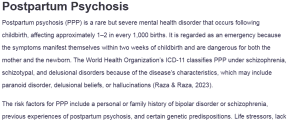Postpartum Psychosis
Postpartum psychosis (PPP) is a rare but severe mental health disorder that occurs following childbirth, affecting approximately 1–2 in every 1,000 births. It is regarded as an emergency because the symptoms manifest themselves within two weeks of childbirth and are dangerous for both the mother and the newborn. The World Health Organization’s ICD-11 classifies PPP under schizophrenia, schizotypal, and delusional disorders because of the disease’s characteristics, which may include paranoid disorder, delusional beliefs, or hallucinations (Raza & Raza, 2023).
The risk factors for PPP include a personal or family history of bipolar disorder or schizophrenia, previous experiences of postpartum psychosis, and certain genetic predispositions. Life stressors, lack of social support, and sleep deprivation can exacerbate the risk (Cleveland Clinic, 2022). The illness is often comorbid with other mental health conditions like postpartum depression or anxiety, compounding the severity and complexity of the mother’s mental state.
Diagnosing postpartum psychosis early is crucial, as the condition escalates quickly. Treatment usually involves hospitalization to ensure the safety of both mother and infant. Medical interventions often include antipsychotic medications, mood stabilizers, and sometimes antidepressants, combined with psychotherapy and family support. With prompt and effective treatment, many women recover well, though ongoing mental health care may be necessary to prevent future episodes.
Prevention strategies are critical, particularly for at-risk individuals. Routine mental health screenings during prenatal and postpartum care can help identify mothers who may benefit from early intervention. Education about PPP symptoms for both patients and families enables early recognition and action.
As a Psychiatric Mental Health Nurse Practitioner (PMHNP), incorporating screening tools and offering support resources during prenatal appointments can mitigate risks (Slivinski, 2022). Additionally, ensuring postpartum check-ins provides opportunities for early treatment, reducing the risks of severe outcomes like suicide or infanticide.
Awareness, screening, and timely intervention are key to preventing the devastating impacts of postpartum psychosis and ensuring new mothers receive the mental health care they need during this critical period.
References
Cleveland Clinic. (2022, September 13). Postpartum psychosis: What it is, symptoms & treatment. Cleveland Clinic. https://my.clevelandclinic.org/health/diseases/24152-postpartum-psychosis
Raza, S. K., & Raza, S. (2023, June 26). Postpartum psychosis. National Library of Medicine; StatPearls Publishing. https://www.ncbi.nlm.nih.gov/books/NBK544304/
Slivinski, N. (2022, January 25). Postpartum psychosis: What it is and what to do about it. WebMD. https://www.webmd.com/parenting/baby/postpartum-psychosis-overview
ORDER A PLAGIARISM-FREE PAPER HERE
We’ll write everything from scratch
Question
Discussion
On June 20, 2001, Andrea Yates horrified the nation when she confessed to drowning her five young children in the bathtub of their suburban Houston home. Andrea, who was 37 years old at the time, suffered from severe postpartum depression, postpartum psychosis and schizophrenia.

Postpartum Psychosis
In your initial post, discuss the epidemiology of post-partum psychosis, including incidence rates, risk factors, comorbidities and treatment options. Also include ways in which you think this illness can be prevented including ways to reduce the risks for suicide and filicide. Include how you will incorporate this prevention into your practice as a PMHNP. Include references.

